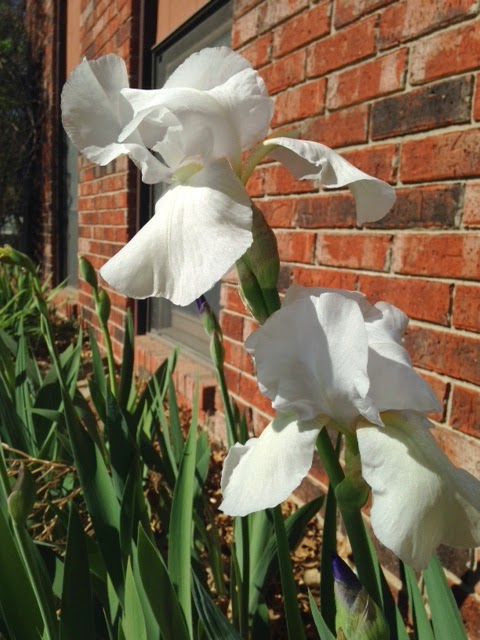About a week ago, I started planting tomatoes. I had previously sorted, repaired, tested for pressure, and roughly laid out the soaker hose in this year's configuration, and I had a start on mapping out those areas I wanted to mulch alongside the growing rows. Those are things I could do while it was still cold.
I chose two tomato varieties this year. Three, if you count the cherry tomatoes, but those are mostly for snacking while I'm in the garden. For the main crop, I chose the nutritious
Black Krim. For my early tomatoes, I chose
Glacier, which I have grown before. I bought all my seeds from
Baker Creek, started my tomatoes on the dining table (March 3) and put them under indoor lights when they germinated (March 6/7). They are pretty spindly, but I know from experience that if I can get them outside and protect them from the cutworms, they will grow out of it quickly. I always plant more than I need to replace those the cutworms harvest.
Fully aware of the gamble, I planted two Glacier on March 21, well before our last average frost date of April 12. If frost gets them, I have more seedlings to replace them, and if they live, I will have a head start on the game!
But I haven't simply left them to the frost wolves. I have given them every chance to succeed, same as the tomatoes that I will continue to plant in stages until they are all in. First, of course, is the soaker hose. That's a must that I have been laying out for years and years. (Soaker hose isn't the same as it was 20 years ago, more's the pity, but that's another story.)
Down each side of the tomato row and between each tomato plant on four foot centers, there will be foot access on mulched ground. The mulch begins with a layer of cardboard (I use boxes when I have them and brown, landscape fabric when I don't) or newspaper (for the small, detail spaces) covered with a natural mulch of whatever I happen to have that year. Leaves are fine, but they break down. Wheat straw is better and desirable, if it doesn't cost me an arm and a leg. This year, I have the remains of a wood chip pile, so I'll toss that around over the cardboard when the tomato plants are all set. (Use caution with wood because it's a taker, as well as, a giver as it breaks down.) If there's a weed outbreak through these layers, I'll toss on another box or newspaper and throw more mulch over that.
This method, a variation of "lasagna gardening" has all kinds of advantages. The tomatoes have as much room as they need to spread above and below the ground. It gives me access from as many sides as I need for picking my ruby treasure. It means I don't have to till the ground, which means I don't need a rototiller, which means no gas, oil, maintenance, labor, or noise. Below is a pic of buckets "planted" in the ground. As I dug those holes, I
gloated over the structure of my soil, a product of many years of care and love for that precious medium, the dirt. Partly that structure is due (among other factors) to the fact that I haven't tilled it.

Those are all things I always do, but I'm adding a little twist this year, the buckets. These are actually plastic plant pots, the ones with drainage holes at the bottom. I've planted them to the rims and left them empty and uncovered, except for a handful of crushed oyster shell I tossed in the bottom of each. As it rains (or when/if I water from overhead), the buckets will collect water and release it about 12 inches lower in the soil, down where thirsty roots can access it, along with any dissolved calcium from the oyster. A bonus was that I dug pretty deep holes, further breaking up the soil for tomato roots that LOVE to ramble. Although I didn't think of it before, I see now that the black plastic is serving as a heat collector for my early seedlings, warming the soil to a considerable depth. It hasn't even rained yet, and I already have a win-win! Later, the tomato leaves will shade the buckets, protecting from overheating in the fierce Kansas solar.
The next step is to actually plant a tomato seedling. This is done by burying the stem right up to the true leaves (pinch off the first leaves), then wrap a bit of newspaper around the stem right at the soil level. This little collar requires the skill of a surgeon, and it's not foolproof. The collar wants to unwind and disappear. I tried tape one time, but moisture in the soil and surroundings released it as well. Despite the difficulty of this niggling step, I still try, because those stems that are covered are protected from cutworms. Where a collar is lost, there is often an extremely disappointing discovery in the morning, a little seedling lying on its side, looking exactly like a tiny lumberjack came through in the night and felled it with an axe. It's my major cause of loss and why I always germinate more tomatoes than I think I'll need.
After planting, tomatoes get a little tray that sits around them like a collar. In the pictures, that is the black plastic form hiding the plants. They come in red these days, too. Mine are old, used many times, so they're the old black, a good color for early planting because it harvests heat. Later, the collars are good mulch.
After the collars, a wire cage goes around each. Not these little 3 foot high cages sold in stores! Even some semi-determinate tomatoes will grow to 6 feet or more in each direction, and I am fond of indeterminate varieties some years, too, which have no check (except for cold) on the height/length they will grow. My cages were given me by my mom, who constructed them out of galvanized wire fencing on 6 inch centers. They are about 20 years old, and the pins at the bottom are mostly rusted, but they're still better than anything I could buy. When they finally rust away, I'll make new ones from new wire fencing. Each cage gets an iron stake, and I often have to add stakes when plants get so large they threaten to topple the entire structure over, especially in a wind storm!

Over the first two Glacier seedlings are the glass cloches I cut from 2 gallon wine jugs. They worked very nicely, although it's probably warm enough now (April 6) to dispense with them. It was sunny all day yesterday, and the cloches would have steamed the little seedlings into a vegetable side dish if I had left them on. I have 3 more jugs to be cut, but I was waiting to see if it was worth it. It is.
While all this elaborate structure is being put together, I use bricks to hold it down. As the pins and mulch and stakes get layered on, the bricks get piled to the side to be used elsewhere and then again and then finally making a pile that I'll use in the fall for even more tasks like tacking down fabric row covers against early frosts.
As of this writing, I have four tomatoes in the ground, two Glacier and two Black Krim, and I have all the buckets "planted." I would plant all the tomatoes if it was not for that fickle fiend, frost! Meanwhile, in the greenhouse, here's some green to soothe the eyes and soul, carrots, lettuce, spinach, onions, a random cilantro, and some pansies I started from seed waaaaaay back in the fall.


















































.JPG)